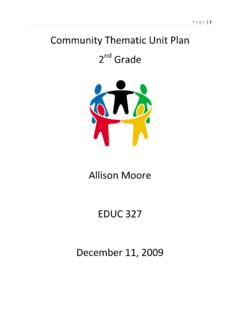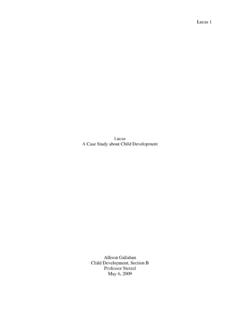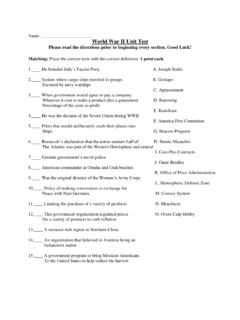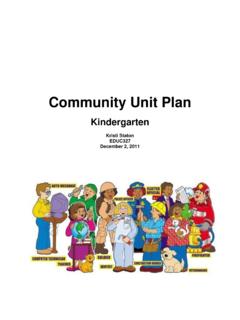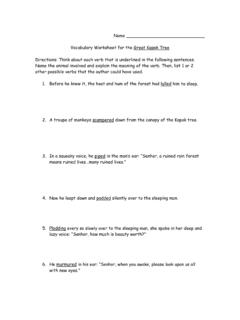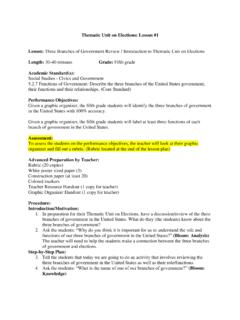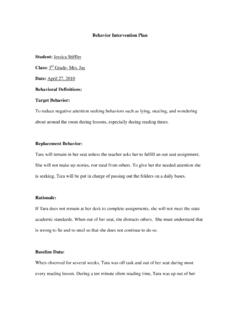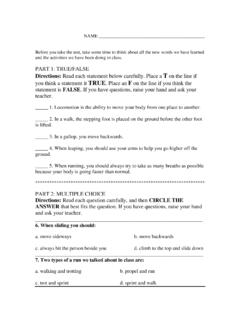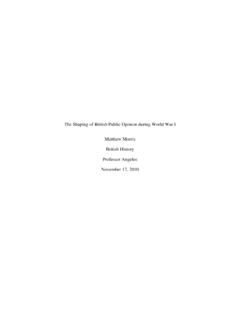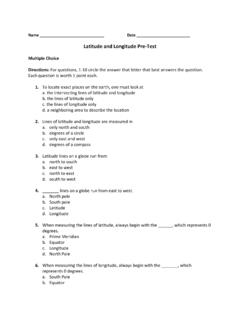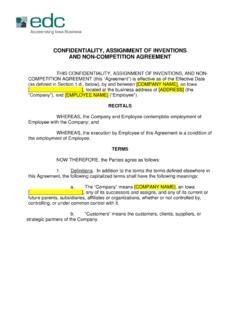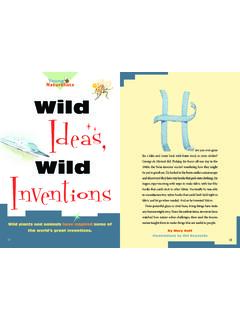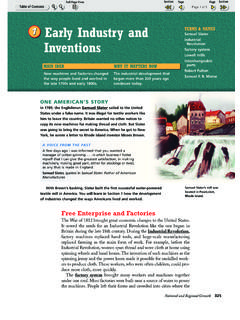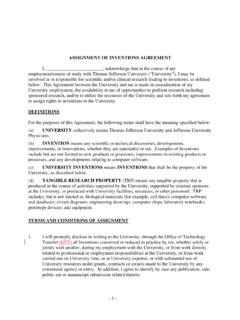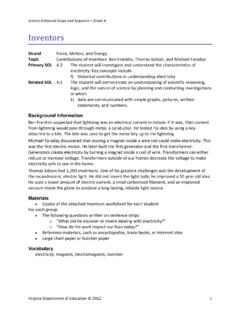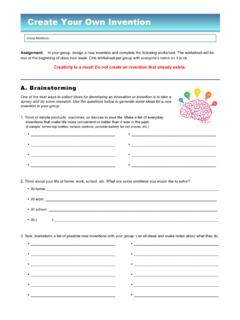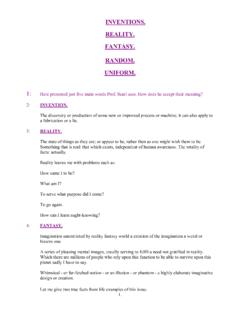Transcription of Inventions from 1776- Early 1900s - Manchester University
1 Inventions from 1776 - Early 1900s Unit Lesson Plan Intended for Fifth Grade Kristina Faudree EDUC 327 December 6, 2011 Table of Contents Introductory Sheet .. Page three Standards .. Page five Curriculum Map/Unit Web .. Page eight Letter to Parents .. Page nine Trade Books .. Page ten Bulletin Board .. Page sixteen Field Trip/Guest Speaker .. Page eighteen Technology and Literature .. Page nineteen Pre-test/Post-test .. Page twenty Lesson Plans .. Page 22- 65 - Introducing Inventors (Writing) .. Page 22 - Creating the Edible Car (Social Studies, Science) .. Page 28 - Rollin Steam Engine (Social Studies, Writing) .. Page 34 - Electricity in Daily Lives (Math) .. Page 39 - Making the Wright Kind of Plane (Art, Writing) .. Page 41 - Decoding the Telephone (Physical Education).
2 Page 48 - Stitching Our Way to Machines (Art, Writing) .. Page 50 - Exploring Primary Sources (Social Studies) .. Page 53 - Becoming a Secondary Source (Social Studies) .. Page 59 - Gallery Walk Presentations (Writing) .. Page 63 Introductory Sheet- Unit Lesson Plan Grade Level and Typical Learner My unit plan focuses on a fifth grade student in the second semester of school. These students are between the ages of ten and eleven. This age level is curious about places and problems in the news because they want to know what is happening in the world and where/why an event has occurred. They are able to apply their skills learned previously in other grades and use them for new situations. Physically, these students are growing in random spurts, which creates awkwardness with their bodies.
3 They are unsure about themselves and the frequent changes cause frustration and anger. At this level these students are learning to read more for fun on their own and are becoming skillful writers by practicing more in the classroom. In all subjects, they learn to apply their skills and use them in real-world situations. National Council for the Social Studies. (1988). Social studies for Early childhood and elementary children: preparing for the 21st century. Retrieved from PBS Parents. (2011). Going to School: Grade-by-grade learning: 5th grade. Retrieved from Rationale Fifth grade students should learn about engineering and technology for many reasons. Within this unit plan, students need to learn about major Inventions and inventors.
4 Indiana State Standards requires fifth grade students to know the Major people, events and developments in the Early history of the United States from 1776 -1801, in standard (Indiana State Standards). This standard can include many different aspects of that time period. I decided to focus on Inventions and incorporated primary and secondary sources in order to allow the students to fully grasp the importance of the Inventions from that time period. For this portion of the unit plan, I used the standard Using primary and secondary sources to examine an historical account about an issue of the time, reconstruct the literal meaning of the passages by identifying who was involved, what happened, where it happened, what events led to these developments and what consequences or outcomes followed, (Indiana State Standards).
5 These standards express the importance of knowing the Early history of the United States and using primary and secondary sources to test and examine history. Fifth grade students should learn this material because they not only learn about historical events, but they can relate the important events from years ago to their lives today. Inventions like the assembly line and airplanes are essential to life today. The NCSS curriculum standards also apply to this unit plan. Time, continuity, and change is one theme because it follows the theme of time and change and comparing the development over time. Another theme is people, places and environments. This theme is based on the specific inventors and where their Inventions were popular, based on the location.
6 The other theme that follows this unit plan is science, technology, and society. Technology has developed drastically over the years and this lesson teaches that because it focuses on the historical technology and how it has adapted over time. By using different teaching styles and methods, I will be able to implement this unit plan over engineering and technology to help students grasp the idea of major developments from 1776 to the Early 1900s . Goals: Students will be able to define primary and secondary sources Students will be knowledgeable about one specific inventor Students will learn the importance of Inventions from 1776 - Early 1900s Students will be able to name and say the importance of the inventors discussed in class (ex: Wright brothers, Henry Ford, Samuel Morse, etc) Students will learn new skills to be applied with each invention (ex: sewing) Standards and Objectives Social Studies: Social Studies.
7 Using primary and secondary sources to examine an historical account about an issue of the time, reconstruct the literal meaning of the passages by identifying who was involved, what happened, where it happened, what events led to these developments and what consequences or outcomes followed (Core Standard) Given an analysis tool sheet, the students will record their observations, reflections, and questions with a total of at least three in each section. Given the Inventor Sheet, students with a partner will fill out all of the questions regarding their partner s inventor with 100% completion. Given the answers from their partner s inventor, the students will present to the class the information they found by reading and hearing about the inventors.
8 Social Studies: Trace the development of technology and the impact of major Inventions on business productivity during the Early development of the United States (Core Standard) The students will write a paragraph of five sentences about the major invention of the assembly line by using their own experience with the edible car. Given the steam engine patterns, the students will create a steam engine with all materials that can be successfully moved. Writing: ( , ) Writing: Conduct short research projects that use several sources to build knowledge through investigation of different aspects of a topic (Core Standard) The students will create a research poster on their assigned inventor by using books and the Internet to find all of the required information according to the rubric.
9 ( ) Writing: Writing narratives to develop real or imagined experiences or events using effective technique, descriptive details, and clear event sequences (Core Standard) The students will write a narrative given the parts of a narrative to describe the steam engine and assembly line to their parents in two pages. Students will write a narrative based on the Gallery Walk by giving examples from their project and at least two other students projects based on the given rubric. ( ) Writing: Recall relevant information from experiences or gather relevant information from print and digital sources (Core Standard) The students will write a one page reflection based on their results from their paper airplane experiment all required form of participation done in class.
10 Writing: Draw evidence from literary or informational texts to support analysis, reflection and research (Core Standard) The students will use the text Something from Nothing to draw evidence to develop a narrative letter with all the specified parts on the given rubric. Science: Science: Investigate the purpose of prototypes and models when designing a solution to a problem and how limitations in cost and design features might affect their construction (Core Standard) Given specified materials, the students will create an edible car in the structure of an assembly line in the span of 10 minutes. Math: Math: Explain which types of displays are appropriate for various sets of data (Core Standard) The students will list all electrical appliances used at home on their Electricity Log sheet with 100% accuracy.
